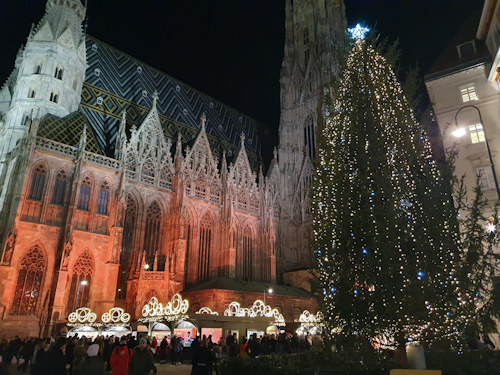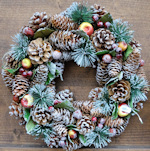
Shake the snow from your boots, put a log on the fire and share a hot beverage with me as we discover the sights, sounds, tastes and traditions of a Christmas trip to Vienna.
(Not to mention a few travel, event, and shopping tips, too.)
- Book a concert experience* for your Vienna trip
- See also:
If you just want some activity suggestions for your seasonal stay, then consider my list of top recommendations: from the best photo opportunity to the glorious gastronomic delight that is the roast chestnut. Otherwise, read on or jump to:
- The markets
- The lights
- Events & activities
- Local traditions
- Food & drink
- Christmas weather
- Shopping tips
- Christmas travel
- Location map
- Useful (or not) German phrases
The Christmas markets
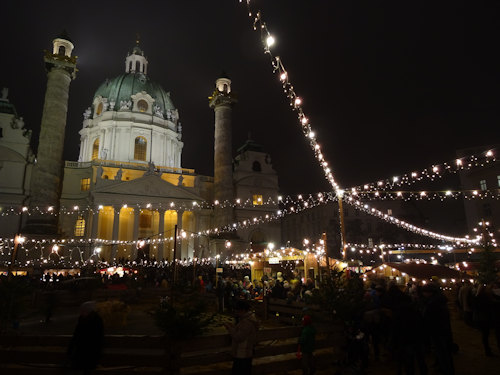
(The Christmas market on Karlsplatz)
Many people visit Vienna at this time of the year for the Christmas markets, which are simply lovely.
Expect the 2024 markets to start opening around early/mid November. A couple of big ones have already named the 8th as the day they begin serving the mulled wine and pastries. Most begin around the 15th and 16th.
The famous Christkindlmarkt and all the main markets continue until sometime between December 23rd and 26th; one or two then stay open longer or morph into New Year versions.
What are they like?
Forget for a moment the bustle and stress of modern life. Instead, travel back to a simpler age (albeit with smartphones).
Breathe in the aroma of fried sausages, melted cheese and goulash soup, the tang of roasted almonds and toffee apples, and the sweet fragrance of countless scented soaps and candles.
Wreathe yourself in wisps of steam from a mug of hot Christmas punch, and fill your eyes with the dazzling displays of artists, craftspeople, cooks, and shopkeepers.
Then eat, drink, and generally be as merry as a reindeer in a carrot field, who’s just heard that Santa picked her for sleigh duty.
(On reflection, you probably can’t forget the bustle of modern life: those markets can get busy.)
Visit the main market page for general information or follow the links below for details and visitor tips for the popular and/or central locations.
Major markets
(The market on Stephansplatz alongside the cathedral)
- Christkindlmarkt on the Rathausplatz (the most popular)
- Karlsplatz (excellent for unusual gifts and unique art)
- Schönbrunn (gorgeous location in front of the Habsburg palace)
- Freyung (surrounded by historical buildings)
- Am Hof (also good for unique gifts)
- Maria-Theresien-Platz (another big one, sandwiched between two 19th-century museum gems)
- Belvedere (in my view, the best photo opportunity)
- Spittelberg (winds through narrow streets and buildings from the early 1800s)
- Stephansplatz (nestled around Vienna’s grand Gothic cathedral)
- Altes AKH (notably good for food and entertaining the kids)
- Hirschstetten (includes a lovely floral exhibition)
Short-term markets
- Medieval Advent market (behind the military history museum; think swords, mead and roast boar)
- Palais Niederösterreich Advent market (in a lovely palais dating back to the Renaissance)
Smaller & alternative markets
- Wintermarkt (mainly food and drink out by the giant Ferris wheel)
- Genussmarkt bei der Oper (near the state opera house)
- Michaelerplatz (in front of the mighty domed entrance to the central Hofburg palace complex)
- Weihnachtszauber (in Vienna’s main brewery; look for the bonus weekend markets in the event hall)
- The winter event at the MuseumsQuartier (art projections and installations, curling, and music of the more modern kind)
Christmas lights
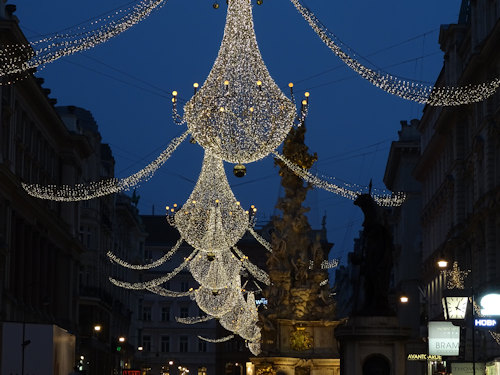
(Christmas lights on the Graben)
All the main shopping streets put on a Christmas display and, of course, many large stores and hotels do so, too.
In terms of colours, Vienna tends not to do gaudy and garish. So expect plenty of classic whites, reds and greens, often with a touch of “alternative” thrown in.
The lights typically go on sometime in the second half of November (without too much advance notice on the specific date) and continue until early to mid-January; the 2023 displays, for example, began on November 16th.
Enjoy some photos and get tips on where to see the best lights with my Vienna Christmas lights guide.
Events and activities
Most museums, palaces and other attractions stay open throughout the Christmas period and I have special pages for November and December activities. But the seasonal highlights include:
Advent concerts

(The Kursalon venue)
Enjoy a whole article with my Christmas concert tips. These include the televised Christmas in Vienna musical gala in the Konzerthaus and other special performances in the major concert venues.
Look out, in particular, for the atmospheric Advent concerts in the central churches and cathedral.
This might also be the time for one of the Mozart & Strauss concerts put on especially for visitors. Light classical music in a historical venue on a crisp winter evening adds another touch of pleasure to the seasonal experience.
Around the markets
Keep an eye out (or ear open) for music as you peruse the markets, too.
For example, traditional extras at the Rathausplatz Christmas market (the Christkindlmarkt) include brass bands, who may play around the Christmas tree centrepiece in the early evenings.
The Schönbrunn and Freyung markets have also had regular performances of music and/or singing in previous years.
Now and then you might also encounter a traditional favourite: Lamentations of the Child (heard when parents refuse to buy yet another stick of chocolate-coated fruit).
Wonderful exhibitions
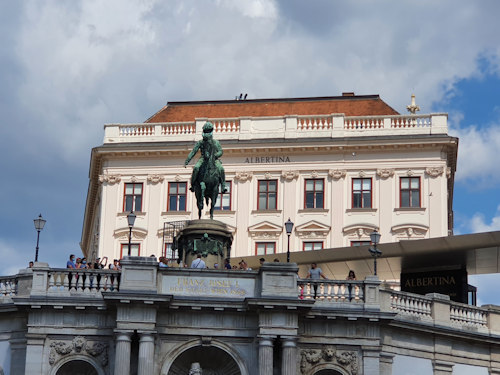
(The Albertina hosts a Chagall-themed exhibition in 2024)
A tradition of late in Vienna is to save the very best exhibitions for the end-of-year season, so expect some glorious art in 2024.
See the What to do in December article or the wider Exhibitions in Vienna page for numerous suggestions. But here are my top highlights in a rich museum and gallery season:
- The Albertina plans an exhibition with around 100 works by Marc Chagall and also offers the prospect of bringing some of Egon Schiele’s lost works to life
- The Kunsthistorisches Museum brings us a major Rembrandt exhibition with works in dialogue with those of Samuel van Hoogstraten
- The Bank Austria Kunstforum Wien has a retrospective for Paul Gauguin
A Christmas Carol
I don’t list individual plays, musicals and similar (the world has only one of me and many of them), but…an English-language performance of A Christmas Carol by Charles Dickens seems too good to ignore. The Open House Theatre production is an annual treat.
Ice skating
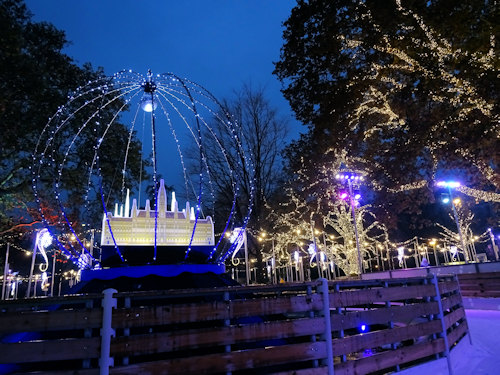
(Ice skating in the Rathauspark)
If you wish to twirl and glide through the crisp Viennese air, then two main central options are:
- The Vienna Ice Skating Association’s large outdoor ice rink that opens from early morning
- The Christkindlmarkt offers up a rather romantic ice skating trail (see photo above) through the adjacent park; it acts as a kind of warm up for the larger Ice World event that begins mid-January, 2025
Local traditions
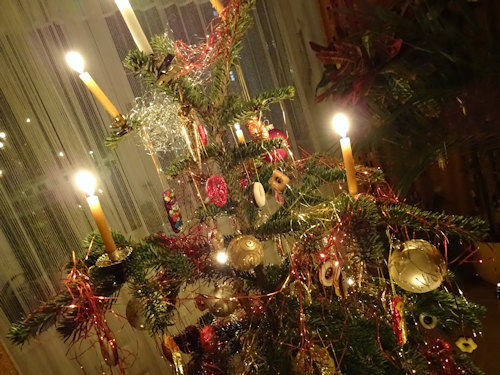
(The traditional tree and real candles)
As Vienna becomes ever more multicultural, it’s tricky to talk about pervasive Christmas traditions. But the big moment of celebration definitely remains Christmas Eve (Heiligenabend).
A “traditional” Christmas for a Viennese family might look like this:
Sometime in the afternoon of December 24th, a handy relative or friend (grandparents are particularly useful here) distracts the kids while the parent(s) decorate the Christmas tree.
When all is ready, someone rings a tinkly bell which announces that the Christkind has been.
The Christkind is the gift bringer: a manifestation of Jesus as a child or an angel, often represented with golden locks and the obligatory wings.
When the bell rings, the kids enter the room and marvel at the magical transformation. Or just make a beeline for the presents.
Inevitably, commercial interests have pecked away at the influence of the retailer-unfriendly Christkind, and pushed for more sleighs and Santa; you can read up on that battle here.
A growing tendency is also to put the tree up earlier. Especially since modern kids with Internet access are less easily convinced by tales of Christmas magic.
Late afternoon or early evening on the 24th then sees the family gather for the Christmas festivities, including carol singing, a hearty meal (see below), and the exchange of gifts and well wishes.
Many people then use Christmas Day (Weihnachtstag) to visit other parts of the family or recover from overindulgence the evening before.
Or, if you live in an Anglo-Austrian household like mine, you celebrate Christmas all over again the UK way: more food, more drink, more forced expressions of gratitude for entirely inappropriate gifts, and, particularly, more complaints about the scarcity of the purple chocolates in a tin of Quality Street.
Food and drink

(Doughnuts and pastries)
As you wander the streets of Vienna in winter, you find numerous little Maronistand booths selling roast chestnuts and potato-based snacks (like wedges). These add to the old-fashioned flair of Christmas markets, together with the many stands selling Christmas punch in a myriad of varieties.
Consumption of chestnuts and punch counts toward your collection of recommended Christmas activities.
The Advent period also offers an excuse to break out the rolling pin and get baking, with certain baked foods only appearing for the Christmas period. Among the more popular seasonal treats:
- Lebkuchen: similar to gingerbread, sold in various shapes, sizes and flavours for eating or as hard-baked decorative shapes that look like they could probably survive a nuclear explosion. A mainstay of the markets, too
- Stollen: a seasonal cross between fruit bread and fruit cake. A little dry, but lots of people seem to like it
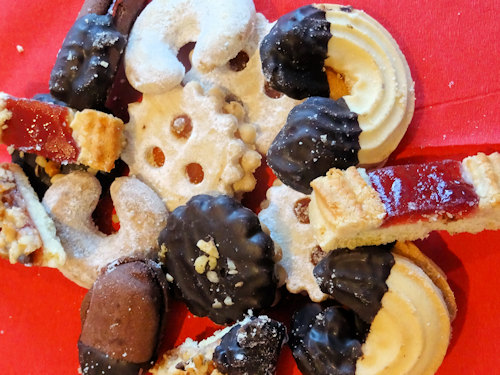
(Christmas biscuits)
- Weihnachtskekse: Christmas biscuits, of which an unending variety magically appear in December.
HardImpossible to avoid if visiting an Austrian family during Advent
- Spekulatius: a spiced biscuit with, frankly, nothing particularly recommending it. But, you know, tradition…
The Christmas meal
The historical Christmas meal in Vienna was carp, often fried in breadcrumbs.
This choice stemmed from the earlier Christian idea of the Advent period being a time of fasting (not something I expect to see a lot of in December 2024).
Fish represented a culinary highlight in the absence of meat, especially for such an important mealtime as Heiligenabend.
Very few people eat carp now, and fish has long lost its appeal as the Christmas dish: roast poultry and pork have become common alternatives. The turkey tradition, for example, enjoys growing popularity through Anglo-American cultural influences.
In our house, we have a meat and tofu fondue as this takes a while to eat, so we’re all together around the table for longer. Although whether this is truly a good thing depends on who’s invited.
Christmas weather

(Um…snow)
The chances of it actually snowing on Christmas Day are revealed here. Don’t get your hopes up, though.
And pack those thermal socks you got last Christmas, but never dared wear. Even if we have yet another mild winter, it gets rather chilly when the sun goes down. Which makes a warming mug of punch at a market even more attractive.
December last year had average temperatures of just over 4°C and a high of just over 15°C. Though on one day temperatures never rose above 0°C.
Shopping tips

(Jams for sale)
The 25th and 26th of December are public holidays, so nearly all stores close on those days. Even those that normally open on Sundays and holidays may be closed (see here for general info on opening times in Vienna).
Despite it being the most important day for family celebrations, the 24th is not a public holiday. However, many (most) shops close early to give staff a chance to get away for Heiligenabend preparations and travel.
The supermarkets tend to unlock their doors early on the 24th and typically lock them again between 1pm and 4pm. So you can still buy the cranberry sauce you forgot (or in case you’re worried 25kg of chocolate is not enough to keep the teenage hordes happy).

(Karlsplatz Christmas market is great for gifts)
Here some tips for seasonal purchases:
- The treats mentioned earlier make nice little gifts. Lebkuchen tends to survive travel better than biscuits and Stollen. For lovely gift-wrapped edible delights, try the Viennese Konditoreien, too
- More and more Christmas markets serve their punch in a collectable mug (for which you pay a deposit). If you don’t mind losing your deposit, you can keep the mug; they make quite unique souvenirs
- The markets are a treasure trove of gift ideas. Candles are everywhere, as well as hats, bags, scarves, jewelry and other fashion accessories, glass, wood, leather and pottery items, jams, honey, wine, schnapps (lots of schnapps), various forms of art, and numerous undefinable things you’ll have trouble finding elsewhere
In particular, consider a shopping trip to the Karlsplatz market. Every stallholder must make their own products and pass a jury test, which ensures a host of booths selling unique handcrafted art and gifts.
Other good ones for excellent and/or unusual arts and crafts are the Schönbrunn and Spittelberg markets.
- If you just want to stock up on basic, mass-produced traditional Austrian-style decorations, then most department stores have a Christmas section selling “standard” decorations for reasonable prices
Public transport
Trains, buses and trams run normally across the Christmas period, but with slightly reduced timetables on selected days. For full details, see the Christmas travel article.
Even reduced timetables in Vienna still make a lot of visitors envious, so you need not worry about getting around.
Location map
All the key Christmas locations mentioned above appear on this map:
And just to finish off this little guide to Christmas in Vienna…
Useful German phrases
- “Frohe Weihnachten” (Merry Christmas)
- “Alles Gute im neuen Jahr” or “guten Rutsch” (Happy New Year)
- “Prost” (Cheers!)
- “Mein Bauch wird gleich platzen wenn ich noch ein Weihnachtskeks esse” (if I eat another Christmas biscuit, my stomach will explode)
Merry Christmas! Frohe Weihnachten!
